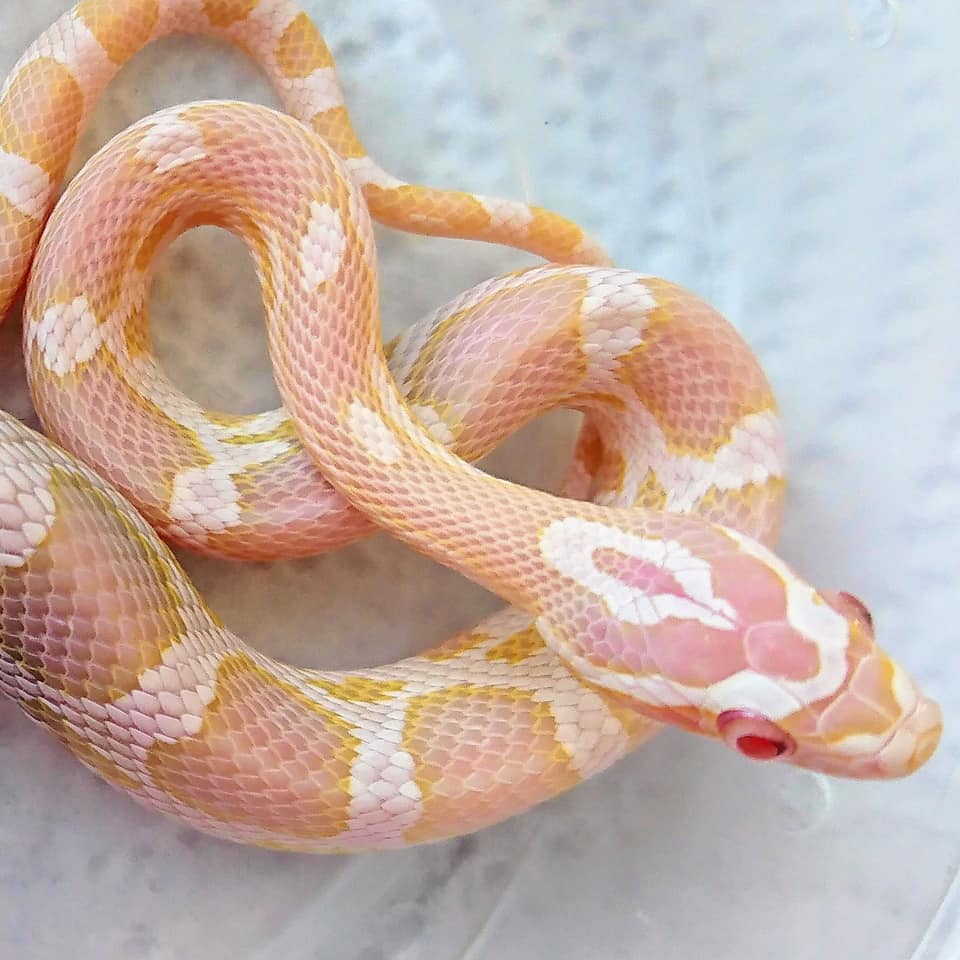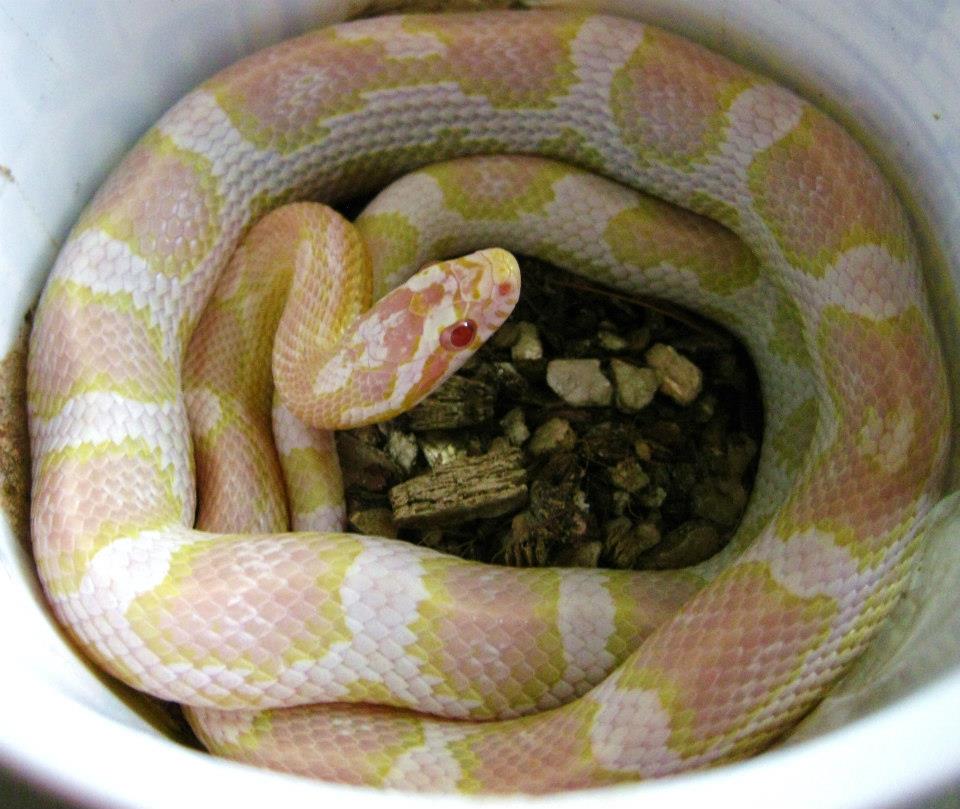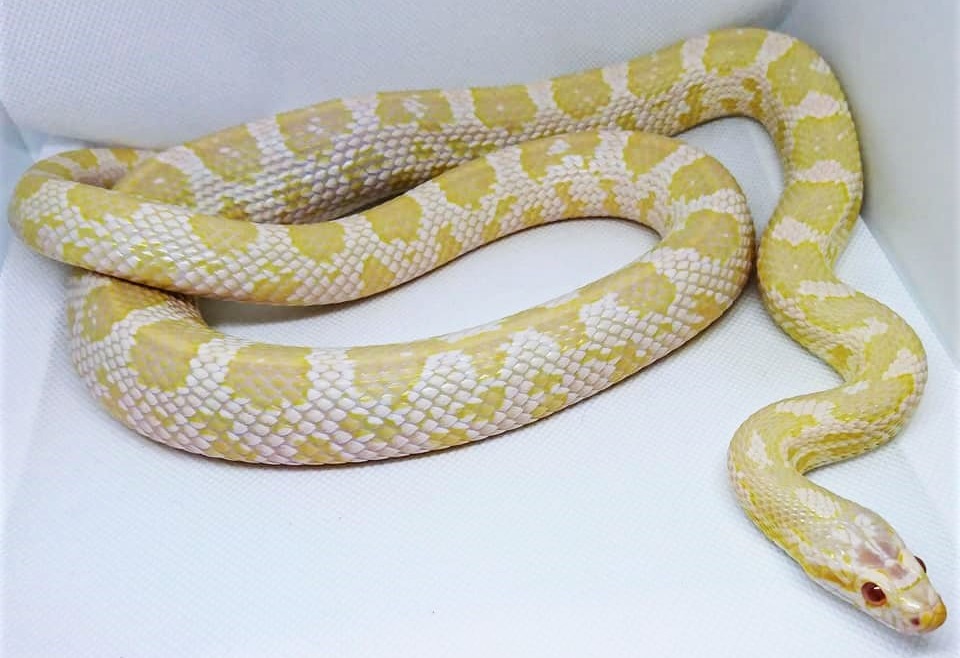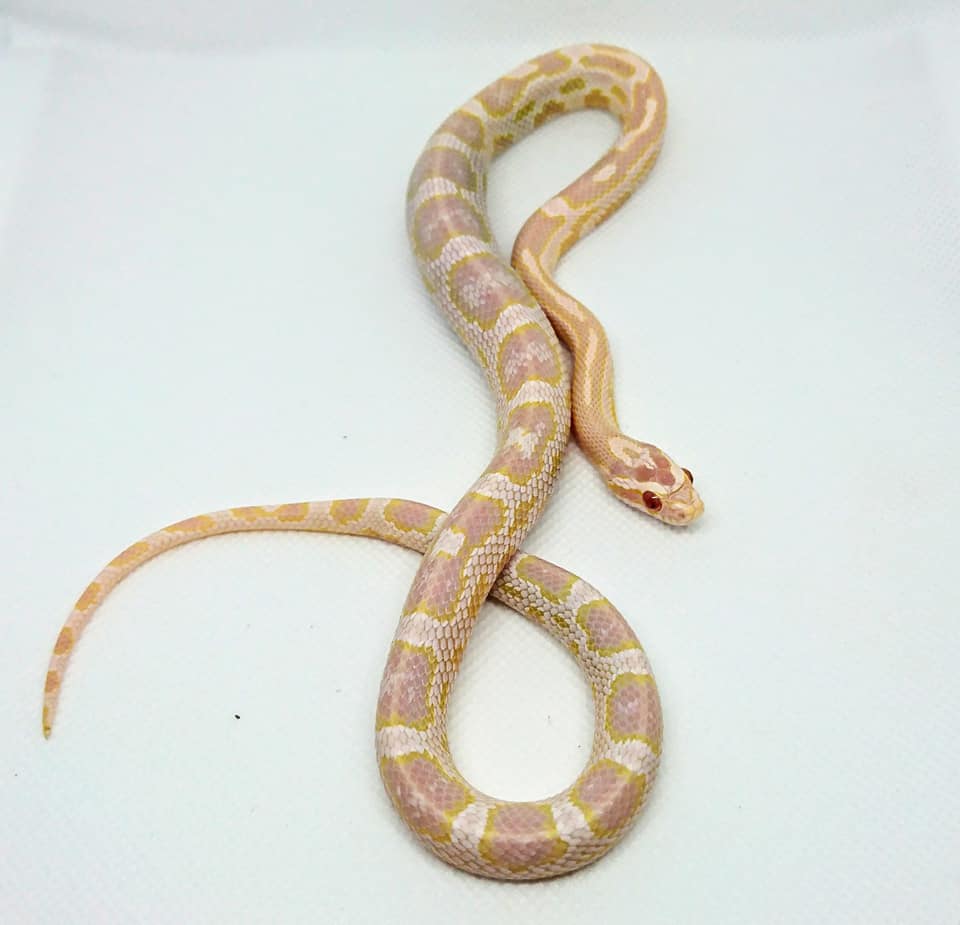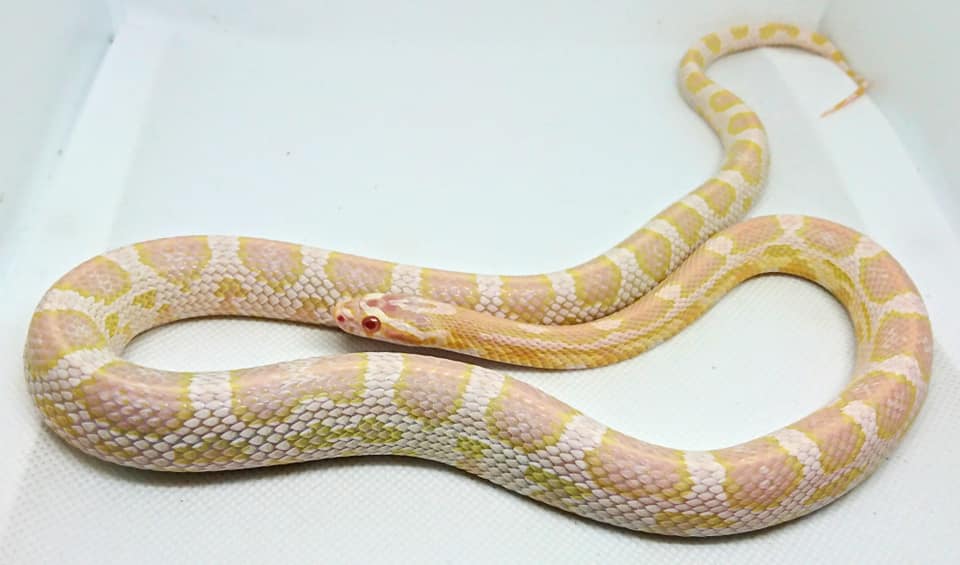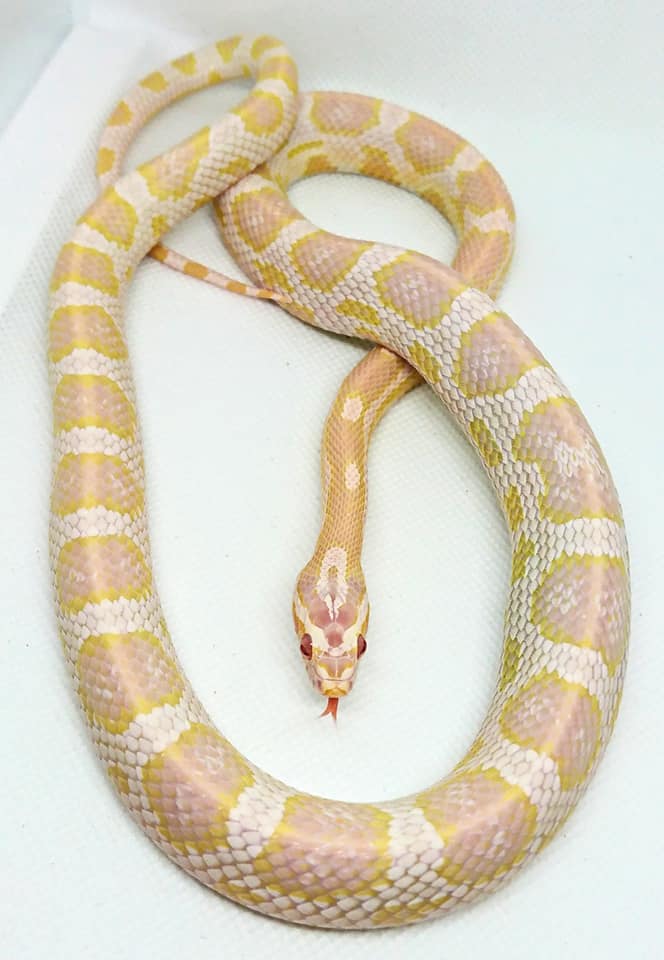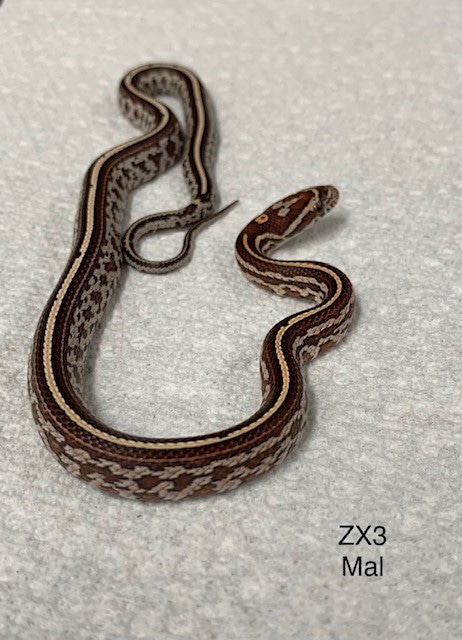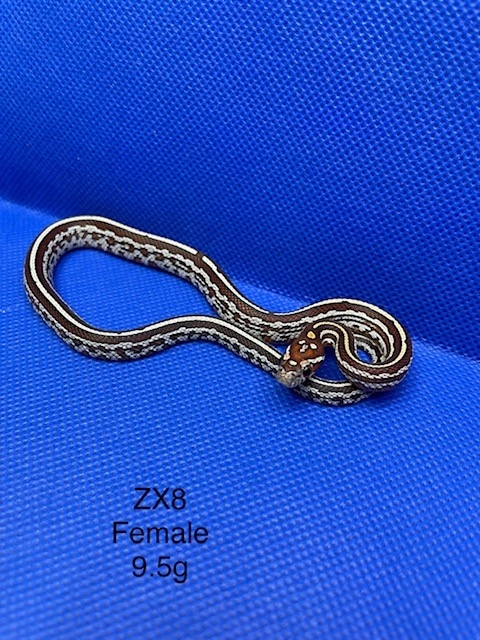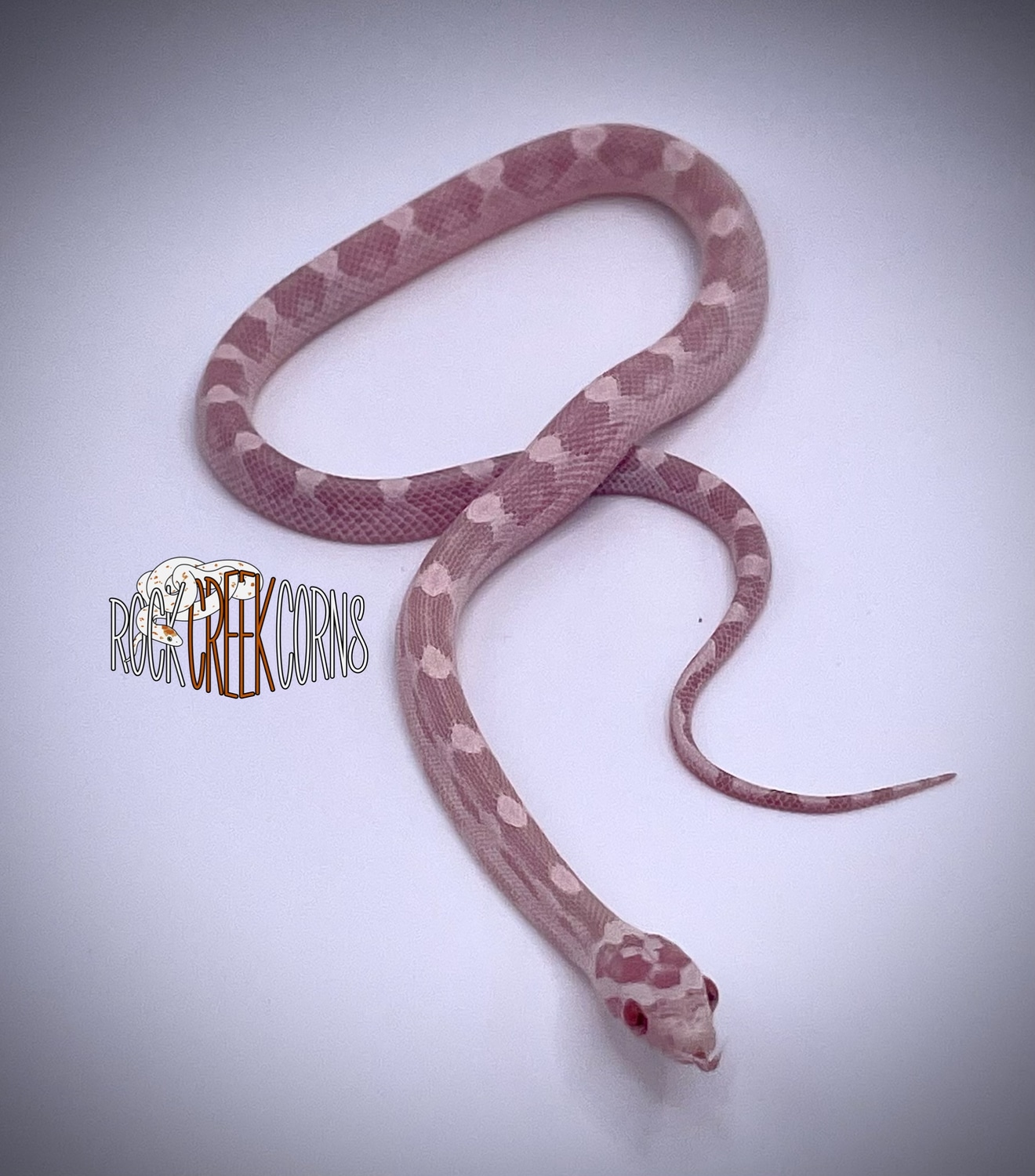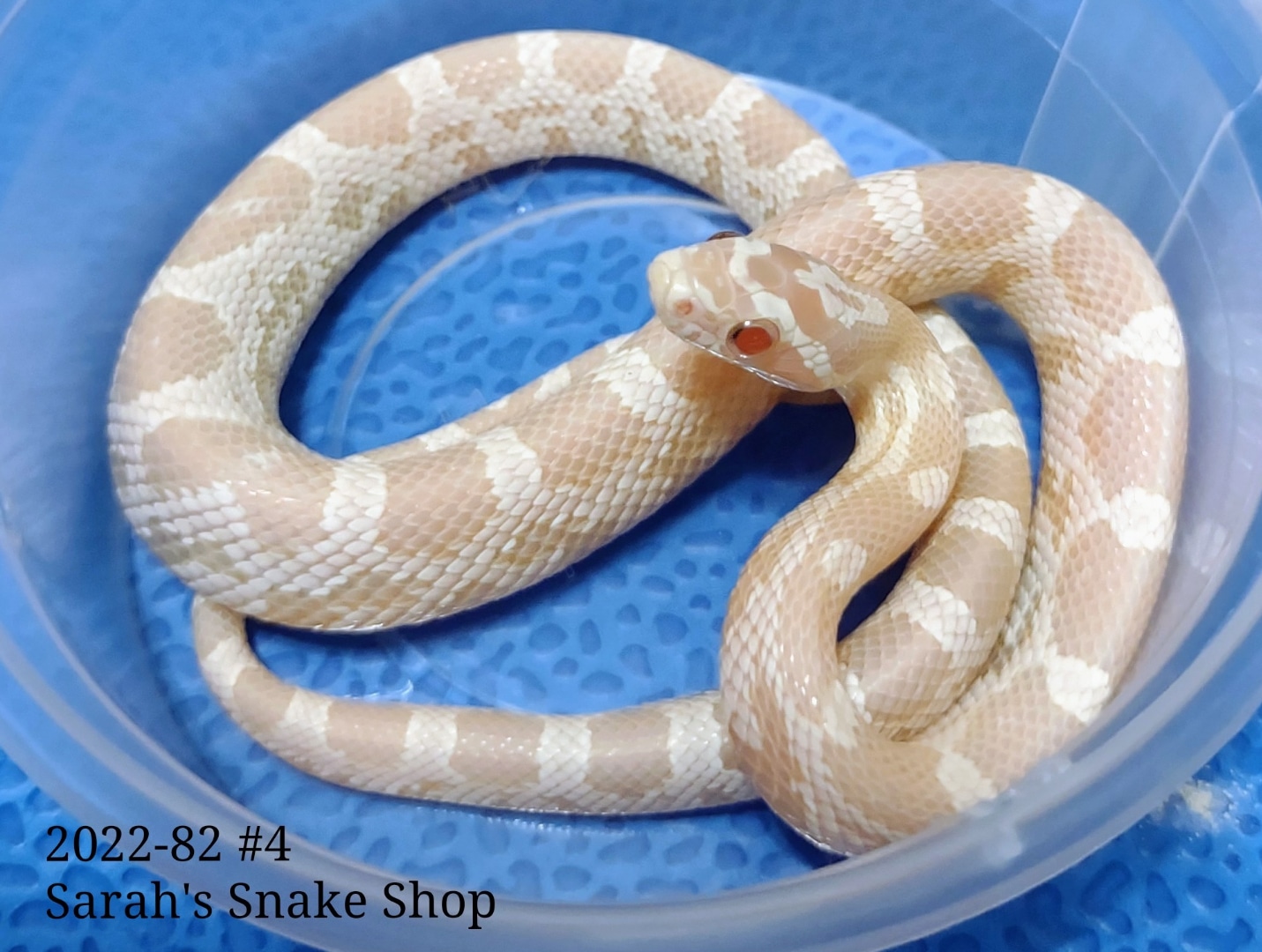Halo
Type: Incomplete Dominant
Aliases: Het Green Blotch
First Produced In: Unknown
Availability: Rarest
Last Updated: 2022-12-12
Do you have any suggestions or corrections for this article?
Click here to contribute feedback
History
"In 2014, Don Soderberg of SMR posted a photo of a High White Amel that had neon yellow saddle borders on his Facebook page. I had a handful of Snows with the same borders, so I commented with a photo of one. Don mentioned to me that it would be interesting if someone figured out what those borders were and how they are inherited.
I have done much of this work, and I’m here to discuss my findings.
The term “Halo” was Steve Roylance’s idea. After my conversation with Don, I messaged a few other breeders to see what their take was on this. I decided to send photos to Steve to get his opinion on them. The first thing he said after I sent the photos was “Wow that’s crazy! Halo corns” - so the term “Halo” stuck.
I’d like to mention before going into the history of my experience with Halo that it cannot be seen in 99.99% of snakes that have melanin in their borders. Melanin masks Halo. There have been special circumstances where I’ve seen the yellow borders in some Hypo-types when they were hatchlings (I’ve produced at least one Ultramel Anery that displayed this), but I’m excluding most information on the non-Amel types because they don’t really help visually.
First Encounter
In May of 2011 I bred a Caramel Motley het Snow female (named Caramel) to an Amel het Anery (named Bo) male.
The Caramel Motley laid 12 eggs that year. 10 hatched and the results were: a few Classics, a few Amels, one Anery, and 2 Snows.
I lost track of most of the babies from this clutch in 2011 – only the 2 Snows, both male, were around long enough for me to see their true colors. One male was sold to a local couple. When they were purchasing more snakes from me 2 years later, they brought him along to show me how he was doing. He was a typical Snow: white and pink-ish with some yellow on the cheeks and sides. Nothing unusual. What WAS unusual was that he looked nothing like his brother, who I still have to this day. Originally I named the 2 Snows from that clutch Prince and Pauper – Pauper was a jerk, that’s why I sold him. But Prince was a sweet snake, and turned out to be the colorful one (Lucky, eh?). This is the male I originally showed to Don and Steve. He has bright neon borders and belly checkers. He isn’t a Green Blotched, the green doesn’t saturate his blotches – just skirts around them.
2nd Encounter
Fast forward 3 years to 2014. In the spring I bought an adult female Snow het Motley (named Pearl) that was advertised as a “Xanthic” – I was excited about this as I thought she would make a good mate for my Golddust Motley het Anery male (unrelated to any of my other snakes at the time), named Nigel. However, when she arrived I was somewhat disappointed in her coloration: she was simply white and skin-toned with a lot of frosting to her saddles… no yellow to speak of, not even any pink - a pretty snake, but not a Xanthic. I bred her to the Golddust Motley anyway thinking maybe she would be het Caramel (why else would they advertise her as Xanthic?); this was clutch #16. She wasn’t het Caramel, but she was het Motley as advertised. I got a nice assortment of Amels, Amel Motleys, Ultramels, Ultramel Motleys, Ultramel Anerys, Ultramel Anery Motleys, Snows, and Snow motleys. Most were sold wholesale. But I didn’t want to wholesale the snows [or the Ultramel anerys] - I thought, with their genetics, they were worth more than wholesale price, so I kept them a little longer.
One male Snow Motley stood out among all the four snows – he started to develop nice yellow borders very early, then I started to see it in one of the female Snows and the female Snow Motley as well. The male Snow Motley and female Snows were bought and paid for before I saw their true colors… I didn’t go back on my word to sell them, so I sent them to their new homes regardless of my desire to keep them. Only one female Snow from this clutch remained ‘dull’ in color, never producing any yellow borders. I kept the female Snow Motley from this clutch (Gumball) as she developed a great yellow color in her borders early on. As an adult, she was completely white (saddles completely frosted out) and had bright neon yellow borders. She was unfortunately killed by my cat in 2016, so she’s no longer with us, but many decent photos of her still remain. The male Snow Motley from this clutch unfortunately passed away with his new owner, so I have no photos of him as an adult – I do still have a few hatchling photos of him showing his yellow borders though.
In 2015, Steve Roylance purchased a 1.1 pair of Halo Snows from me from these two lines. A male [Prince’s son, I named PJ] Halo Snow 50%ph Caramel Motley, and a female [Pearl & Nigel’s Daughter, Pebbles] Halo Snow het Caramel Motley.
Other Clutches
At that point I owned 2 pairs of snakes capable of producing the “Halo” look in their snow offspring, and maybe in the Amel offspring as well (but never kept an Amel long enough to know for sure if it would show there too).
This is where it gets complicated, so try and stay with me – I will use the names of each of the snakes so it’s [hopefully] easier to keep straight.
To attempt to ‘prove’ this as a genetically inheritable mutation here’s what I’ve done thus far.
- Bred Bo to Pearl in 2015. This was an attempt to discover if Halo was recessive. If it was recessive, this breeding [two non-Halo parents that have created Halo offspring] would have produced roughly 1/4 Halos, with the majority not being Halo. After holding back all of the offspring from this breeding for over 6 months, none of them showed any signs of yellow in the borders. Bo was famous in my collection for producing amazing Reverse Okeetees, and this clutch was no exception. This gave a larger canvas for Halo to be painted if it was going to show up at all, but it never did. This was enough for me to believe that Halo is not recessive.
- Bred Prince to a female Classic het Snow in 2015. This classic originated from WC stock: she was an F1 from a WC x Snow that did not show any yellow in its borders. Perfect tester female. Sure enough, at least one snow [PJ, now owned by Steve Roylance] was a Halo. This meant that Halo was inheritable in a single generation at the very least.
- Bred Prince to another Halo [Kimmy]. In 2015, Jessica Kimble of Cornbred Reptiles bred her yellow checked Blizzard het Anery male [who also has a few yellow flecks in his saddle borders here and there] to a female Amel het Anery. This female displayed some yellow in her borders too, though not much. This breeding yielded some Amels and some Snows. A few of her snows began showing the yellow Halo borders. She contacted me, knowing I had this Halo project, and offered two Snow females to me. One was nearly completely Green Blotched, the other was a perfect Halo – like most of mine. The Green Blotched female passed away, but the Halo [Kimmy] is still around and is currently gravid – Prince is the sire, naturally. This current breeding is a repeat, however. I bred this pair in 2017 and 8 Snow babies were produced. I held them all back for about 6 months (1.2 are still in my collection). After about 3 months I started noticing some major differences in the clutch. 2 of the babies were plain… No color to speak of, just white and pink-ish. But one was the polar opposite: she started to develop yellow not only in her borders, but her saddles as well – a Green Blotched. The rest were Halos. This seemed to line up with Jessica’s breeding – two snakes with Halo in their borders yielding a decent mix of Halos, Green Blotched, and non-yellow-bordered snakes.
What does this mean?
Theories
Given how the breedings have gone this is the current theory: Halo is possibly the heterozygous form of an incomplete-dominant mutation, with Green Blotched being the homozygous form.
Halo has been around forever - I’ve seen photos from the 1990s of Snows with the yellow borders - but it was never tested. I believe that my Caramel Motley het Snow female who produced my original male Halo in 2011 was the carrier for that strain. But with her having melanin it unable to be seen. If I’m correct, she would have been het Halo.
Then in 2014, I believe my Golddust Motley was the carrier – same issue with the melanin. He also would have been het Halo.
Jessica’s Amel and Blizzard both would have been het Halo since they produced both Green Blotched and Halos – with some of the Amels and Snows having no additional yellow at all.
I also acquired a Fire female from my friend Mike Burkhamer who displayed these yellow Halo borders. She unfortunately escaped, never to be seen again, but I did snap some photos of her beforehand. Mentioning this to say – Halo can also easily be seen in Amel types that don’t include Anery types.
Rachel Ingram also had an Amel with these bright yellow borders. Her Amel is technically a Creamsicle, however. The Halo borders are just as common in Emoryi as they are in corns. But I do not think – I repeat, do NOT think – that this is a hybrid gene. The oldest photos I’ve seen of ‘Halo’ Snows were actually Salmon & Coral Snows. These were likely not hybridized, so Halo has been a part of corn snakes for just as long as, or longer than, it has been a part of Great Plains rats. These two species are very closely related, so it’s even possible that this mutation has been passed down since before the species split, especially if it is dominant or incomplete dominant… even more especially since this ‘mutation’ does not harm any snake in the wild that has melanin (i.e. it doesn’t make it easier for predators to find them and be picked off, it’s a neutral mutation – neither helpful nor hurtful on its own).
The Coral and Salmon Snows are also a testament to removing Caramel as a cause for the Halo effect. Originally, when I realized that all of my Halos came from Caramel stock, I thought that maybe Caramel was the cause somehow. However, with all these Coral and Salmon Snows that have been line-bred for generations showing the Halo yellow borders, it became clear that this was not a part of Caramel, nor was it a part of Coral or Salmon: it was something else entirely (not all Corals/Salmons have this yellow). Also adding in the fact that Jessica’s Amel and Blizzard did not produce any Caramel based offspring, therefore they are likely not both het Caramel… therefore Caramel is not the cause of their Halo-ness.
So far it isn’t known for sure how it’s inherited, but I see no way it can be recessive – after breeding Bo (father of my original Halo) and Pearl (Mother of the 2nd strain of Halos) together and getting no Halos whatsoever, the possibility of it being recessive was ruled out.
I’ve taken into consideration that the ‘strains’ I produced were two completely different genes entirely; that each of these ‘strains’ weren’t actually the same thing… and that it is, in fact, recessive, but because they are on different alleles then no Halos could be produced from that breeding. However, that has already been proven wrong this season by Steve Roylance’s pair from these two strains; at least one baby from the clutch is already displaying yellow borders, even before his first meal. If these two strains were different and recessive, none of the offspring would display the Halo borders.
Though I have not yet bred any of these directly to a WC to prove it out, I’ve done everything except that. And everything points to a dominant or incomplete-dominant gene. I mention dominant (instead of just sticking with inc-dom) because there has not been enough evidence, in my mind, to conclusively say that Green Blotched is actually a homozygous version of the gene. It could be that, even in heterozygous form, Halo creates Green Blotched on occasion. Perhaps there’s yet something else at play that causes Green Blotched… like yet another mutation that fills the gaps between the borders with yellow. I don’t know for sure.
I’ll also add here that I’ve recognized the possibility that this is a selectively bred trait. In many cases, a selectively bred trait can seem like a gene mutation, but through extensive breeding trials it fades away and proves itself to not be a mutation.
However, due to the extensive breeding that’s already been done in the Coral and Salmon lines, I’d say that the fact that Halo is still holding strong is a testament to its likelihood of being a genetic mutation.
Going full circle with Don’s High White Reverse Okeetees – it was note worthy to me, at least for the purpose of this thread, that Don posted a photo of 2 high white sisters with yellow borders on his website (snake of the day 2/22/18). The only thing I’m wondering is: what did the parents look like? I’ve messaged him about this and am awaiting a reply.
I heard back from Don (Thanks Don!) about the two Yellow-bordered high whites I mentioned - they are owned by Catherine Turley but were possibly produced by Sean Niland at VMS.
I believe I’ve already proved it is not recessive.
The 2011 breeding was between a Male Amel that didn’t show yellow borders X Caramel motley - no way to know of the Caramel Motley ‘shows’ the Halo or not due to the melanin.
The 2014 breeding was between a Female Snow that didn’t show yellow borders X Golddust Motley - once again, no way to know if he was Halo or not.
Then I took the two visual Amels and bred them together in 2015 (the Male Amel from 2011 and the female Snow from 2014). This resulted in no additional yellow at all. There were both Reverse Okeetees and Snows from that breeding, but even after holding them back for a year, none of them showed any yellow borders.
If it WAS recessive, there should have been Halo offspring from that breeding. Since there was not, I don’t believe it’s recessive.
As for it being Incomplete-Dominant or Dominant, more testing will have to be done on the Green Blotched from this line. It’ll be years before I do that breeding, so maybe someone will get to it first? I know Don S. has some nice Green Blotched Snows that he’s breeding, but I’m unsure if he’s done any actual testing on it (probably not since he indicated to me that ‘someone else’ should do it lol). It it at least inheritable in the first generation, that I know for sure.
The hardest part about Halos and Green Blotched is that the yellow isn’t obvious at first, sometimes it takes up to a year for it to come in. So most breeders don’t want to hold back 30 babies for a year to wait for that.
As for what the future holds… I’ve seen it in Amels, Snows, Blizzards, Mandarins, Peppermints, Butters, and all those + pattern the mutations. I think I’d eventually like to see how it works with Lavender since Opal combos are the only Amel based mutations that may not be able to show it. Aside from that (which I plan to try in the next few years), I’m unsure where I hope it goes…? - scmartin27
Appearance
Body
Yellow borders/blotches. In the case of the Het version it shows yellow in the borders of the snake, in the hom version the yellow extends to fill the saddle-shaped blotches as well. Also have yellow belly checkers when checkers are present. Only visible when combined with Amelanistic (in the majority of cases).
Belly
Yellow Checkers
Proven Lines
No known proven lines.
Related Traits
No known related traits
